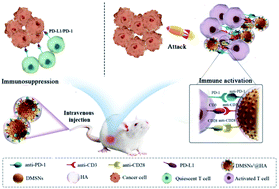A dendritic cell-like biomimetic nanoparticle enhances T cell activation for breast cancer immunotherapy†
Abstract
Cancer immunotherapy has remarkably improved the therapeutic effect of melanoma and non-small cell lung cancer in the clinic. Nevertheless, it showed disappointing clinical outcomes for treating immunosuppressive tumors, wherein aggressive T cells are rather limited in tumor sites. Therefore, regulating the behavior of T cells in tumor sites to increase their attack ability for suppressing the immunosuppressive tumor is highly desirable. Inspiringly, we designed a dendritic cell-like biomimetic nanoparticle (DMSNs3@HA) to regulate the behavior of T cells for improving the immunotherapy effect against immunosuppressive tumors. In this work, anti-CD3 and anti-CD28 were responsible for mimicking dendritic cells to activate T cells, and anti-PD-1 for blocking the pathway of PD-1/PD-L1 to break the immune “brake”, which synergistically regulated the behavior of T cells to attack cancer cells. Experimental results indicated that DMSNs3@HA can effectively activate T cells and improve their immune response to significantly inhibit the growth of breast cancer. Moreover, it also proved that T cell activation combining immune checkpoint blocking induced the “1 + 1 >2” immunotherapy effect against immunosuppressive tumors. We expect that this strategy will provide new insights into tumor immunotherapy by modulating T cell behavior.



 Please wait while we load your content...
Please wait while we load your content...